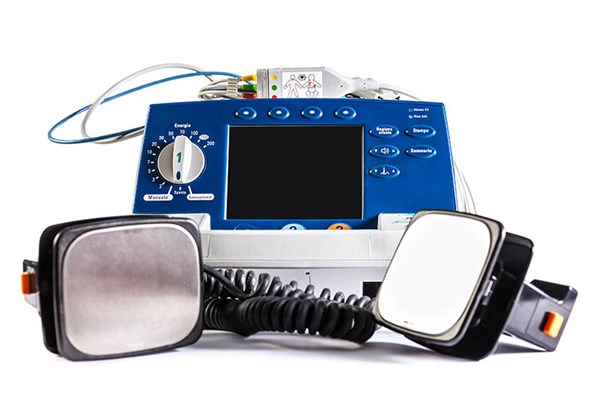Are you considering double sequential defibrillation in patients with refractory VF? Perhaps you should.
Case
A 54-year-old male suffered witnessed cardiac arrest while shoveling snow. Bystanders initiated CPR; EMS administered 4 defibrillations and maximal doses of antiarrhythmic agents before bringing the patient into the hospital in refractory ventricular fibrillation (VF). Double sequential defibrillation (DSD) was attempted, with successful return of spontaneous circulation (ROSC) after cardiac arrest. The patient was discharged home neurologically intact.
Introduction
In out-of-hospital cardiac arrest, the administration of rapid, high-quality CPR dictates outcomes of Adult Cardiopulmonary Life Support (ACLS). Patients in arrest with a shockable rhythm (ventricular fibrillation [VF] or ventricular fibrillation [VT]) have a higher rate of survival.1 However, a subset of patients with VT/VF do not respond to CPR, medications, or defibrillation; these are considered to be in refractory VF. A recent chart review demonstrated that up to 0.5% of patients receiving out-of-hospital CPR are found to be in refractory VF.2 Improved out-of-hospital CPR technique and increased bystander CPR have increased chances of survival for out-of-hospital arrest. Patients have a longer window in shockable rhythms with good neurological outcomes, which has created opportunities for initiation of external defibrillation and potentially treatment with double sequential external defibrillation (DSD). For this case we define DSD as the use of 2 sets of defibrillation pads: one set in the standard positioning and a second set either lateral or orthogonal (anterior/posterior) to the first. While standard defibrillation involves the delivery of electrical current via a single asynchronized electrical cardioverter, DSD uses the 2 separate defibrillators to fire nearly simultaneously, allowing for greater energy transmission and augmented vectors of energy to travel through the heart.
Multiple case reports and review articles have described Refractory VF.3 The use of DSD has been postulated as a method for improvement of treatment for these patients. Multiple theories suggest that this method may benefit select patients. During DSD, the patient’s myocardium receives broader and multiple energy vectors, which could help reset the electrical rhythm. In addition, it may lead to more complete depolarization of the myocardium or decrease the defibrillation threshold, making a second shock more effective. A recent retrospective cohort analysis showed there was no added harm from DSD and single defibrillation in patients with refractory VF after three 200 J shocks.4 In a recent retrospective chart review of 12 patients in refractory VF, 9 out of 12 were converted and 3 out of 12 had ROSC.2
Although DSD has not demonstrated direct harm to the patient, a recent case report has shown that DSD may lead to damage of each defibrillator.5 Such reports raise concern for patient safety if damage is not identified prior to the next attempted use. Reported damage to defibrillators may be due to positioning of defibrillation pads; the pads may be placed too close together, resulting in diversion of current between the devices instead of through the myocardium.5 In this index case report, the two devices involved were from different manufacturers with proprietary programming, which may also play a role in the resultant damage. Currently, DSD is considered off-label use as manufacturers do not test devices in this manner and cannot ensure reliable functionality during DSD. The off-label use of DSD may lead to voiding of warranties if there is any damage. Due to these concerns, explicit policies should be developed to specify appropriate indications for DSD, correct pad placement, and post-DSD testing of devices prior to returning to service.
Conclusions
With improvements in out-of-hospital emergency systems and emphasis on high quality CPR, patients have the potential for good neurologic recovery despite longer arrest times. Given the high likelihood of demise in cases of refractory VF and the potential for meaningful neurological recovery with ROSC, clinicians should consider DSD for patients who are found to have failed conventional antiarrhythmic and standard defibrillation. Institutions should create protocols for the use of DSD, including specific indications, pad placement, and device testing after use.
Summary Points
- DSD should be considered for patients with refractory VF.
- DSD is the use of 2 separate defibrillators to deliver nearly simultaneous shocks.
- The pads can be placed with one in the conventional location and a second beside it, or in the anterior/posterior arrangement.
- EM teams should work with their hospital to create a protocol for the use of DSD.
References
1. Sasson C, Rogers MA, Dahl J, Kellermann AL. Predictors of survival from out-of-hospital cardiac arrest: a systematic review and meta-analysis. Circ Cardiovasc Qual Outcomes. 2010;3(1):63-81.
2. Cortez E, Krebs W, Davis J, Keseg D, Panchal A. Use of double sequential external defibrillation for refractory ventricular fibrillation during out-of-hospital cardiac arrest. Resuscitation. 2016;108:82-86.
3. Pourmand A, Galvis J, Yamane D. The controversial role of dual sequential defibrillation in shockable cardiac arrest. Am J Emerg Med. 2018;36(9):1674-1679.
4. Ross EM, Redman TT, Harper SA, Mapp JG, Wampler DA, Miramontes DA. Dual defibrillation in out-of-hospital cardiac arrest: A retrospective cohort analysis. Resuscitation. 2016;106:14-17.5.
5. Gerstein NS, McLean AR, Stecker EC, Schulman PM. Defibrillator Damage Associated With Attempted Synchronized Dual-Dose Cardioversion. Ann Emerg Med. 2018;71(1):109-112.



